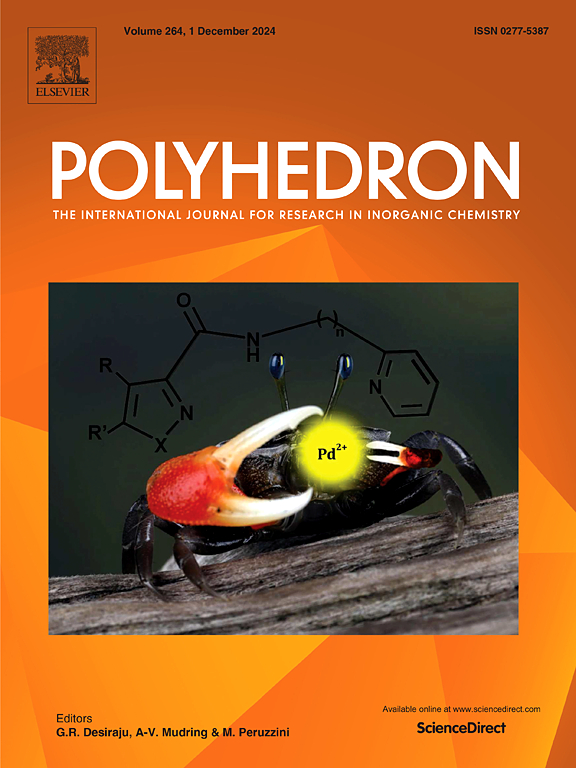晶体结构研究,光谱学,量子化学研究,以及Ni(II)基杂化材料的生物学评价
IF 2.6
3区 化学
Q2 CHEMISTRY, INORGANIC & NUCLEAR
引用次数: 0
摘要
在过去的几十年里,基于过渡金属配合物的杂化材料及其种类繁多的配体由于其多功能性、结构可调性以及广泛的生物和技术应用而越来越受到人们的关注。本文研究了一种新型配合物[Ni(C6H9N2)2(H2O)4](SO4)2.4H2O(简称Ni- 3amp)的合成及结构表征。单晶x射线衍射证实了一个具有八面体Ni2+配位环境的三斜晶系。光谱研究,包括FT-IR, UV-Vis和光致发光分析,证实了关键官能团的存在,包括- oh, - nh2, - C=C -等。他们发现了强烈的蓝色辐射,理论(DFT/CAM-B3LYP/LanL2DZ)计算支持观察到的结构和电子特性。Ni-3AMP的Hirshfeld表面分析显示,约45%的接触以O⋯H型接触为主,这些接触是C-H⋯O、N-H⋯O和O-H⋯O型的氢键相互作用。利用代表DNA旋解酶亚基B的ATPase结构域的两个P. aeruginosa靶点(7PTF和7PTG)进行分子对接模拟,与环丙沙星(CIP)相比,与Ni-3AMP的结合亲和力更高。环丙沙星是一种标准的抗菌药物,其结合亲和力分别为- 139.60 kJ/mol (7PTF@Ni-3AMP)、- 108.90 kJ/mol (7PTF@CIP)、- 130.27 kJ/mol (7PTG@Ni-3AMP)、- 110.84 kJ/mol (7PTF@CIP),多个氢键分别为11、10、5、5。体外抗菌实验进一步揭示了其强大的抗菌活性,特别是对铜绿假单胞菌和大肠杆菌,超过环丙沙星。这些发现表明,Ni-3AMP是一种很有前途的多功能药物,在生物医学治疗和光电子领域具有潜在的应用前景。本文章由计算机程序翻译,如有差异,请以英文原文为准。

Crystal structure investigation, spectroscopy, quantum chemical studies, and biological evaluation of a Ni(II)-based hybrid material
Over the last few decades, hybrid materials based on transition metal complexes and their wide variety of ligands have attracted increasing attention due to their multi-functionality, structural tunability, and wide range of biological and technological applications. In this study, the synthesis and structural characterization of a new complex compound [Ni(C6H9N2)2(H2O)4](SO4)2.4H2O (abbreviated Ni-3AMP) were carried out. Single-crystal X-ray diffraction confirmed a triclinic crystal system with an octahedral Ni2+ coordination environment. Spectroscopic investigations, including FT-IR, UV–Vis, and photoluminescence analyses verified the presence of key functional groups including –OH, –NH2, –C=C– etc. They revealed strong blue emission, with theoretical (DFT/CAM-B3LYP/LanL2DZ) calculations supporting the observed structural and electronic properties. The Hirshfeld surface analysis of Ni-3AMP shows that about 45 % of all the contacts are dominated by O⋯H type contacts, which are the hydrogen bond interactions of the C-H⋯O, N-H⋯O and O-H⋯O, type. The molecular docking simulation using two P. aeruginosa targets (7PTF and 7PTG) representing the ATPase domain of DNA gyrase subunit B demonstrated superior binding affinity with Ni-3AMP compared to ciprofloxacin (CIP), a standard antibacterial drug with binding affinities of −139.60 kJ/mol (7PTF@Ni-3AMP), −108.90 kJ/mol (7PTF@CIP), −130.27 kJ/mol (7PTG@Ni-3AMP), −110.84 kJ/mol (7PTF@CIP), and multiple hydrogen bonds of 11, 10, 5, 5 respectively. In vitro antimicrobial assays further revealed potent antibacterial activity, particularly against P. aeruginosa and E. coli, surpassing that of ciprofloxacin. These findings suggest that Ni-3AMP is a promising multifunctional agent with potential applications in biomedical therapeutics and optoelectronics.
求助全文
通过发布文献求助,成功后即可免费获取论文全文。
去求助
来源期刊

Polyhedron
化学-晶体学
CiteScore
4.90
自引率
7.70%
发文量
515
审稿时长
2 months
期刊介绍:
Polyhedron publishes original, fundamental, experimental and theoretical work of the highest quality in all the major areas of inorganic chemistry. This includes synthetic chemistry, coordination chemistry, organometallic chemistry, bioinorganic chemistry, and solid-state and materials chemistry.
Papers should be significant pieces of work, and all new compounds must be appropriately characterized. The inclusion of single-crystal X-ray structural data is strongly encouraged, but papers reporting only the X-ray structure determination of a single compound will usually not be considered. Papers on solid-state or materials chemistry will be expected to have a significant molecular chemistry component (such as the synthesis and characterization of the molecular precursors and/or a systematic study of the use of different precursors or reaction conditions) or demonstrate a cutting-edge application (for example inorganic materials for energy applications). Papers dealing only with stability constants are not considered.
 求助内容:
求助内容: 应助结果提醒方式:
应助结果提醒方式:


